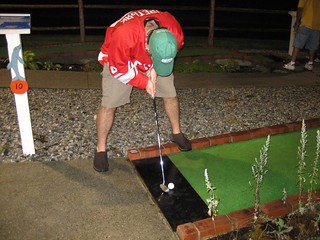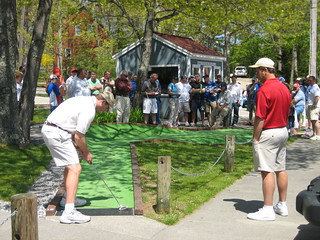What's in a tournament? (Part II)
by Pat Sheridan on 04/18/15
I guess it is fitting that this post comes mere days after a Bones episode about the death of a professional miniature golfer. I hope I'm not in for the same fate! My tournament preparation at 27 days out consists of zero putting but does include a cider and cigar on my deck.
USPMGA tournaments follow a similar path of a local tournament but there are more rules governing equipment and play. For those players who jump from local tournaments, or never have played in a local tournament, playing in a USPMGA tournament could be a shock if you aren't prepared.
Cost and Duration: To play in a USPMGA tournament you first need to be a registered USPMGA player, which costs $25-$40 a year depending on when you send in your fees (due each year by Feb 1). Entry fees are usually $50 - $150. The duration will vary but 8 to 10 rounds of stroke play is normal and played over at least two days.
Divisions: There is usually multiple divisions including amateur, seniors and womens. Sometimes they are separate tournaments and other times they are sub-divisions within the main professional division, since there is nothing keeping people from all persuasions playing in the main event. One of the great things about miniature golf is that women and men do play in the same tournament and there's nothing keeping them from being on equal footing. However, the number of women who play in USPMGA events isn't as high as it should be.
Purse: The U.S. Open this year will have a cash purse of at least $8,000 and the Masters will have $12,000. There are smaller UPMGA tournaments ($2,000 - $5,000 total purses) but in general there's good money on the line. I don't do it for the money but it doesn't hurt to walk away with some cash.
Competition: The U.S. Open will feature at least 20 of the best miniature golfers in the United States and some from around the world. The smaller USPMGA tournaments will have not quite as many but still a high level of competition for the top spots. There will also be a good amount of folks entering who are local to the course and like in a local tournament, they give everyone a run for their money because of their knowledge of the course. I would love it if we could convert every "local" player to a USPMGA player though to grow our ranks.
Equipment: The official ball of the USPMGA is the Calloway Hex Chrome with the USPMGA logo on it. Only those balls can be used in USPMGA tournaments. I find it kind of dumb that players can't select their own brands the way some in the PGA would but I am not the one running the show. Luckily, they don't decide what types of putters we can use. I use a Calloway White Hot blade putter. I like the blades because on those rare occasions when you need to make a left-handed shot, it's not impossible to do like if I had a ball putter.
Clothing: There's rarely a dress code in a local tournament other than what is the normal code at the course of shirts and shoes. I've been known to wear jerseys of many sports (hockey, baseball, football, cricket, etc) at these tournaments ala Happy Gilmore. The USPMGA, however, expects a little more class. You have to wear closed toe shoes (i.e. – no sandals) and a collared shirt as a man. For me this means a combination of The Putting Penguin and KPMG (my employer and sponsor of Phil Mickelson) shirts and a corresponding hat.

Me rocking a USSR hockey jersey during a tournament in Maine in 2006
Play: In my experience it seems like the pairings in the USPMGA tournaments are based on skill level versus random match ups. There is a benefit to playing someone at your same level and in a future post I'll discuss what you should do if you're lucky enough to be paired with someone better than you. Similar to local tournaments, play is honors and the rounds are played in groups. For example, you might play 3 rounds in the morning, get re-paired and play 3 rounds in the afternoon before being re-paired again the next day. Many times a tournament will also repair for the final round so the top players go against each other while the rest of us get to watch some excellent minigolf after we finish.
The rules are set by the USPMGA and like a local tournament will cover aspects such as where to tee off, how much you can move the ball off the wall and what to do when the ball goes out of bounds. Players will keep each other's scores and turn in the scores at the end of the each round, most of the time signing the scorecards just like in the PGA.
One big difference in the USPMGA tournaments is the crowds, in that there tends to be some. We don't get Masters' level galleries but there can be a few spectators from the area and often a local news organization or two will show up for the larger tournaments. As a mid-level player I'm hardly in the spotlight but it's great to see our sport getting press.

Matt McCaslin playing the final hole with a crowd in the 2008 U.S. Open
Scores: One thing we didn't talk about in the local tournaments was the winning scores. The totals always vary based on the course but in almost all cases you are looking at scores averaging less than 3 per hole. USPMGA events become even tougher on the scores with many having winning scores of less than 2 shots per hole (or under 36 per round). In fact when you ask a USPMGA player about "par" on a course, we always assume everything is a par 2 and we're always shooting for aces. Don't be intimidated though – we'll talk in future posts on how to get your scores down!
Ready to play yet?

